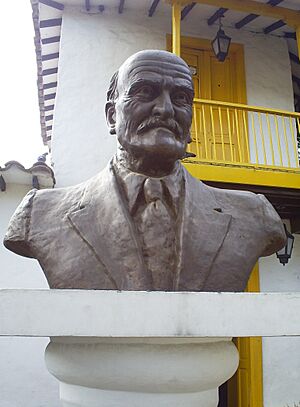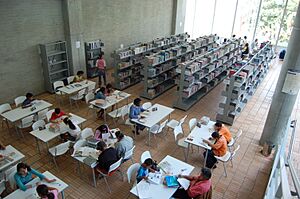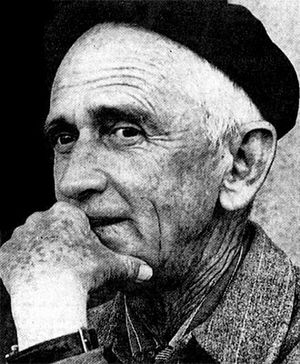Tomás Carrasquilla facts for kids
Quick facts for kids
Tomás Carrasquilla
|
|
|---|---|
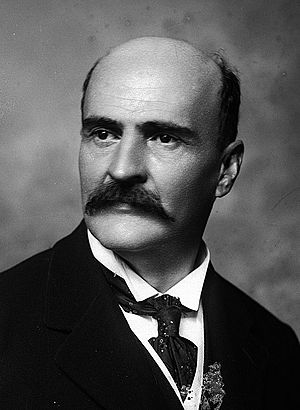 |
|
| Born | 17 January 1858 Santo Domingo, Antioquia, Colombia |
| Died | 19 December 1940 (aged 82) Medellín, Antioquia, Colombia |
| Occupation | novelist, storyteller and essayist |
| Language | Spanish |
| Education | University of Antioquia Medellín - Colombia |
| Literary movement | Out of category due to his particular style. Some link him to Costumbrismo |
| Notable works | Simón El Mago (1890) La Marquesa de Yolombó (1926) |
| Notable awards | Colombian Academy of Language – Jose María Vergara y Vergara National Prize of Literature and Science 1936 La Marqueza de Yolombó Cross of Boyacá |
Tomás Carrasquilla Naranjo (1858 – 1940) was a famous Colombian writer. He lived in the Antioquia region. Tomás worked many simple jobs, like a tailor or a storekeeper. He loved to read and became one of Colombia's most original writers. His stories greatly influenced young people of his time and later.
For a long time, not many people knew about Carrasquilla. This changed in 1936 when he was 78 years old. He won the National Prize of Literature, which made him famous across Colombia. The Tomás Carrasquilla Library Park is named in his honor today.
Tomás Carrasquilla could not finish his studies at the University of Antioquia. This was because of the civil wars happening in Colombia during the late 1800s. He was a dedicated thinker. He organized social gatherings called tertulias at his house in Medellín. At these meetings, people read books and talked about them. Many young writers joined these groups. They started calling him "Maestro Tomás Carrasquilla" (Master Tomás Carrasquilla). The Colombian philosopher Fernando González Ochoa was one of his big fans.
Some experts say Carrasquilla's work was not well-known at first. This is because he lived between two different literary styles. These were Costumbrismo (focused on local customs) and Romanticism. Then, Modernism started, which was a new style. Many people see Carrasquilla's work as Costumbrist.
Contents
Life and Times of Tomás Carrasquilla
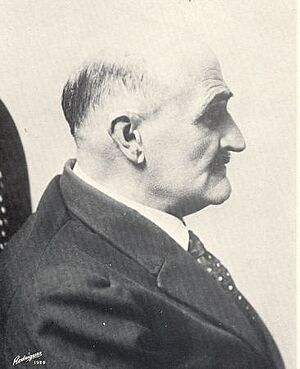
Tomás Carrasquilla lived through two centuries. He connected two important times in Colombia's history. When he was born in 1858, the country was called the Republic of New Granada. It had just become free from Spain. In his book La Marqueza de Yolombó, Carrasquilla wrote about how ordinary people saw these big changes. He showed how they felt about Colombia becoming independent.
He also lived when the country was called the United States of Colombia (1863–1886). During this time, the Paisa Region saw new areas being settled for coffee farms. He also saw Colombia's industrial revolution in the early 1900s. He lived through the Thousand Days War and many other changes.
The civil wars of the 1800s stopped Carrasquilla from finishing his law studies. He was studying at the University of Antioquia.
One of these civil wars appeared in his books Luterito and El Padre Casafús. These stories were set during the civil war of 1876. This war started because some groups in Antioquia, Cauca, and Tolima disagreed with the government. The government wanted to make education less religious. Carrasquilla's books show the deep feelings of people during these historical events.
Early Life and Education
Carrasquilla was born in Santo Domingo. This is a town in the mountains, north-east of Medellín. His parents were Isaza Carrasquilla and Ecilda Naranjo Moreno. His family owned some gold mines. This meant he had enough money to live comfortably and focus on writing. Francisco de Paula Rendón, another writer, was also from Santo Domingo and a friend.
When he was 15, he moved to Medellín. He finished high school at the University of Antioquia. He then started studying law there. But he had to stop his law studies in 1877 because of a civil war.
He went back to Santo Domingo. There, he worked as a tailor and did other jobs for the town. Carlos Eugenio Restrepo invited him to a "literary café." To join, he had to write a story. He wrote Simón el Mago (Simon the Mage). This became one of his most famous stories. Simón was published in 1890. It was even made into a movie in 1993 by director Víctor Gaviria.
Becoming a Writer
In 1896, Carrasquilla went to Bogotá. His first novel, Frutos de Mi Tierra (Fruits of my Land), was being published. He wrote it to show that any topic could be a story. Critics liked the book very much. On this trip, he met José Asunción Silva. Years later, he wrote an essay about Silva called "For the Poet."
He returned to Antioquia but had an accident. He fell from a horse and had to stay in Medellín for a while. When he went back to Santo Domingo, he focused on writing. In 1904, he lost his money because a bank went bankrupt. He then worked as a storekeeper in a gold mine in Sonsón until 1909.
After this, Carrasquilla moved back to Medellín. He had a very active social and cultural life. He spent time with young thinkers like Fernando González Ochoa. González became one of his best friends and a big admirer. Carrasquilla also knew the cartoonist Ricardo Rendón. He supported a group called Los Panidas, but he never officially joined them.
In 1914, Carrasquilla wrote for El Espectador, Colombia's oldest newspaper. At that time, it was published in Medellín. Soon after, he moved to Bogotá. He worked for the Ministry of Public Works until 1919.
When he returned to Medellín, he kept studying literature. In 1928, he published La Marqueza de Yolombó (The Marchioness of Yolombó). This is one of the most famous Colombian books.
Later Years and Recognition
Carrasquilla stayed in Medellín as his health got worse. He started to lose his eyesight. In 1934, he had surgery that helped him see a little better. But being blind did not stop him from writing. He began to dictate his stories to others.
In 1935, Carrasquilla received the Cross of Boyacá. This is a very high award in Colombia. It gives the person who receives it special honors.
He dictated Hace Tiempos (Long Time Ago) between 1936 and 1937. This book won him the José María Vergara y Vergara National Prize of Literature and Science. This award from the Colombian Academy of Language brought him national fame. It also attracted international critics who admired his work. They helped bring his name out of being almost unknown.
In December 1940, Tomás Carrasquilla passed away. Many friends and admirers were with him. They called him "Don Tomás" or "Maestro Tomás Carrasquilla."
Carrasquilla's Unique Writing Style
People often describe Carrasquilla as a Costumbrist writer. This is because his stories often show the traditions and daily life of simple people. They also describe the scenery in detail. Costumbrismo was a style popular in Spain and Latin America in the 1800s. It aimed to describe the customs of a people without adding much opinion.
However, a new style called Modernism appeared in the late 1800s. Modernism was a reaction against Costumbrismo. In Colombia, Modernism included writers and artists like González and Greiff. Tomás Carrasquilla knew about these new ideas. He even supported groups like Los Panidas. But he kept his own special way of writing.
According to writer Federico de Onís, Carrasquilla was always an independent writer. His great skill was that he did not just copy others. He took ideas from different styles but kept his own unique voice. His stories always showed the spirit of Antioquia.
Journalist Carlos Uribe de los Ríos believes that calling Carrasquilla only a Costumbrist made his work less known for a long time. Some writers in Bogotá looked down on him. They thought he was just a "provincial" writer from a small area. But Carrasquilla was a master at taking simple everyday stories. He turned them into amazing, deep, and beautiful tales. He was great at details and choosing the perfect words. He always kept the reader interested. He could be funny, sometimes tough, and tender when needed. He made ordinary stories exciting.
Friendship with Fernando González
One thing that shows Carrasquilla was more than just a Costumbrist was his friendship with Fernando González Ochoa. González was known as the filósofo de Otraparte (Philosopher from somewhere else). Even though González was 39 years younger, they were great friends. González met Carrasquilla when he was starting Los Panidas in Medellín.
González, who was also a great Colombian writer, wrote about Carrasquilla. He said that Carrasquilla observed and listened a lot. He was like a "tailor of clothes and souls." González felt that Carrasquilla was unique in Colombia. He was a source of pride for the country.
Important Works
During his life, Carrasquilla's books were mostly known in the Paisa Region. But after 1936, when he won the National Prize, his work got attention from critics around the world. Writers from Chile, like Arturo Torres Rioseco and Mariano Latorre, admired his work. He also corresponded with famous writers like José Martí and Miguel de Unamuno.
Carrasquilla wrote many types of works. These included novels, short stories, essays, articles, and letters. In 1906, he wrote to a friend that he was writing because of money problems. He had lost his fortune. But he generally lived comfortably and never married. He wrote some articles for El Espectador, but he was not mainly a journalist.
Novels
|
Short Stories
CollectionsCarrasquilla's articles and stories appeared in different publications. Later, they were collected into two books:
|
The Marchioness of Yolombó
La Marquesa de Yolombó (1928) is a historical novel. It is one of Carrasquilla's most popular books. It tells the story of a Colombian town in the late 1700s. This was when people were fighting for independence from Spain. The novel describes the different social groups of the time. Spaniards and Spanish Americans were at the top. Black people and mestizos (people of mixed heritage) were in lower social classes. At that time, Yolombó was an important town because of the gold mines in Antioquia.
Simon the Magician
Simón El Mago is a short story written in 1890. In this story, Carrasquilla made fun of witchcraft. It also shows the relationships between white and black people in Colombia in the late 1800s. It explores how different beliefs mixed together. In the story, a young boy named Toñito is cared for by his nana (nanny), Frutus. She tells him stories about witchcraft, which fascinates him. The boy decides to try out his nana's lessons. This leads him into big trouble, and his father has to punish him.
See also
 In Spanish: Tomás Carrasquilla para niños
In Spanish: Tomás Carrasquilla para niños


